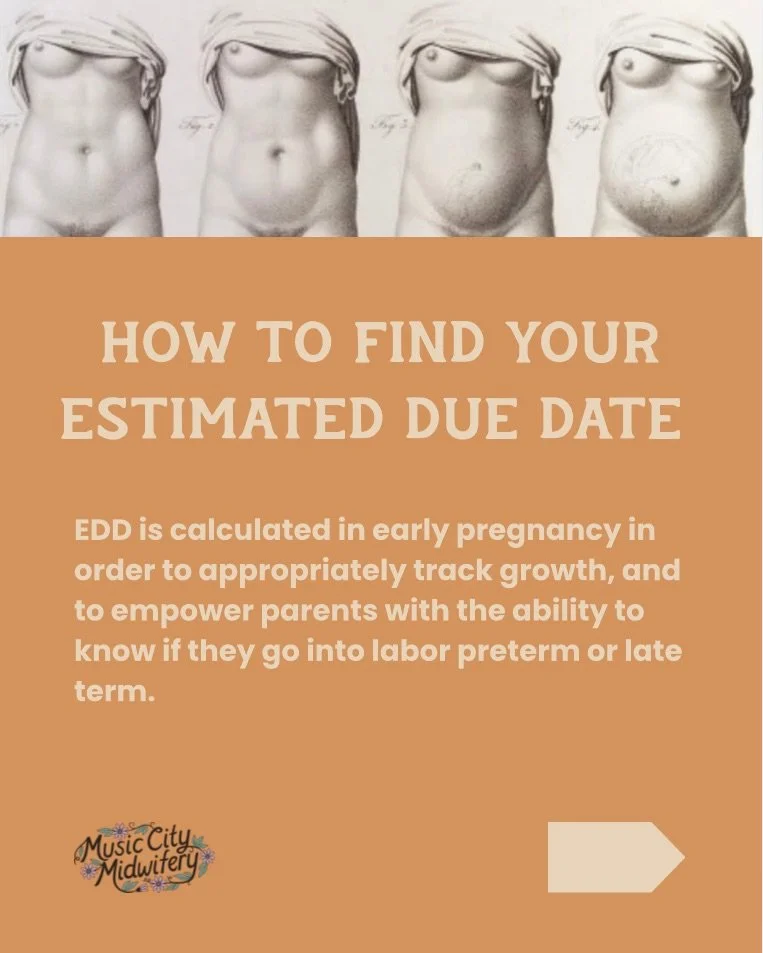How to find your Estimated Due Date
It’s 2025, and as midwives in prenatal appointments we find many more people than even five years ago know that Estimated Due Dates (EDDs) are more so projected windows of time when babies may arrive than precise eviction dates. The traditional method of calculation, called Naegele’s Rule, was created in 1812 based on the belief that all pregnancies naturally end at 280 days, or 40 weeks after the first day of the last menstrual period (LMP). His theory is based on the assumption of a 28 day menstrual cycle, ovulation on day 14, and is not based in any modern research standards. It’s calculated by adding seven days to the first day of your LMP, and then subtracting three months. Most apps and online calculators use this method to generate EDD.
Multiple recent, high quality studies point to early pregnancy ultrasound actually being more accurate in calculating estimated due dates than going off last menstrual period. This is likely due to more than a few factors, the first being that many people do not have regular or consistent 28 day cycles. Additionally, many of us do not ovulate on exactly the 14th day of our cycles. The time it takes for a fertilized egg to implant in the uterus and become an embryo is also not the same for everyone. Remembering LMP can also be tricky! Research shows that we are more likely to remember a date with the number 5 or with even numbers, so there’s potential for misremembering the correct date our last period began.
Early ultrasound
Your guy, Franz Naegele
If you without a doubt know the date of conception because you have been consistently and accurately tracking your cycle for an extended period of time and know without a doubt the day you ovulated, or if you got pregnant with in vitro fertilization, your EDD can be accurately calculated by simply adding 266 days to the day you conceived. This is more accurate than using Naegele’s Rule because it doesn’t rely on the assumption of ovulation at day 14.
Even with greater accuracy, it’s important for your sanity during pregnancy to have the expectation that you very likely will not have a baby on your estimated due date! Research shows that in first time parents, 50% of pregnancies end by 40 weeks and 5 days, and 75% complete before 41 weeks and 2 days. For women who have previously given birth. 50% will give birth by 40 weeks and 2 days, and 75% give birth by 41 weeks.
So why even calculate with ultrasound if EDD itself isn’t really precise? Research shows that families who calculate estimated due date with an early pregnancy ultrasound are less likely than those who calculate with LMP to have an induction for post-date pregnancy, or going a certain amount of time past their estimated due date.
In early pregnancy between 11 weeks and 13 weeks 6 days, development and size are very consistent across healthy pregnancies, so during this time it is easier for ultrasound to calculate an estimated due date. Families in studies who have had early ultrasounds in this window of time had the highest chance of going into labor within 11 days (give or take) of their due date. After 13 weeks 6 days, there’s more differences across pregnancies in development and overall size, based on parental genetics. Because of this variation, it’s harder to accurately calculate EDD after 13 weeks 6 days with ultrasound.
Having an accurate estimation of where we are in pregnancy can be important for reliably being able to answer questions like, “Is this normal at this point?” and for overall risk assessment. We do not require our families in and around Nashville to have early pregnancy ultrasounds, but we do want you to have all the facts when making these kinds of decisions about your pregnancy care, starting from the very beginning.
Want to read more? Here are some sources we trust, in order from most approachable to not as approachable:
How Accurate are Due Dates? EBB Podcast
The Evidence On: Due Dates, Evidence Based Birth
Ultrasound for fetal assessment in early pregnancy, Cochrane Library
Predicting date of birth and examining the best time to date a pregnancy, Khambalia et. al



